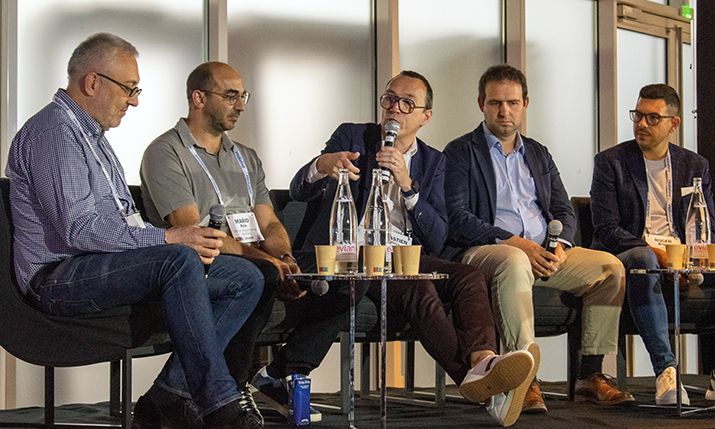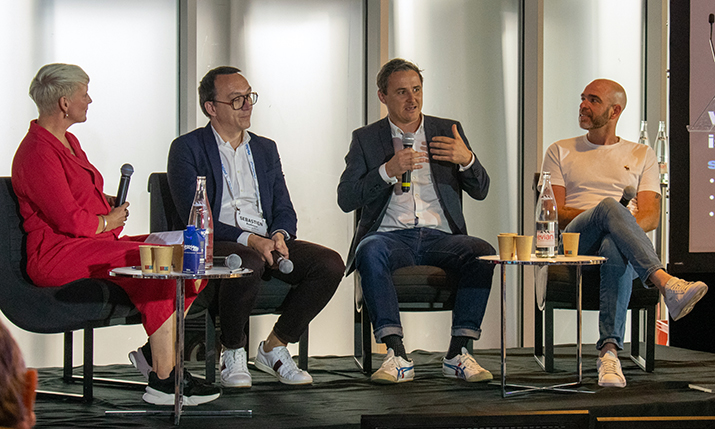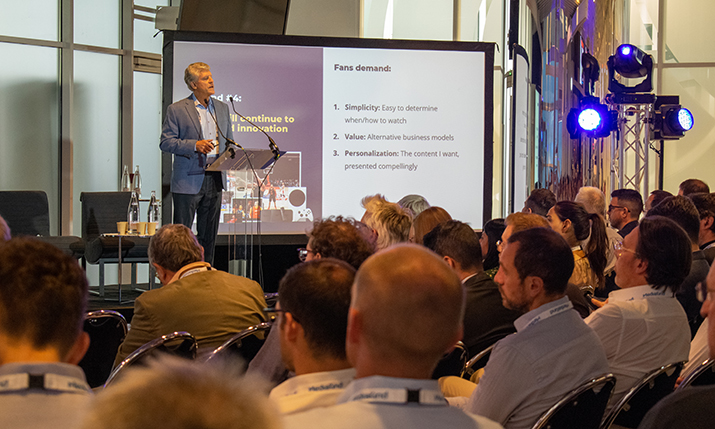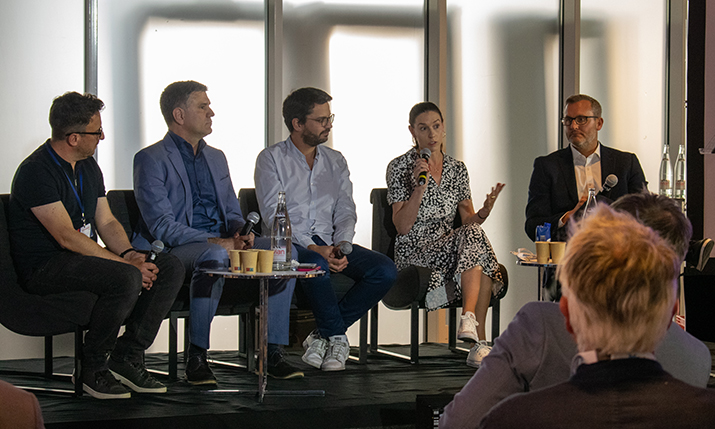Sports OTT Summit: Fan engagement, monetisation and Web 3.0 top the agenda in Paris

The State of the Streaming Nation was an insightful discussion from leaders in sports broadcasting, chaired by Orange’s Nicolas Deal and including OBS’ Mario Reis, Canal+’ Sébastien Audoux, the DFL’s Dominik Scholler and LaLiga’s Roger Brosel
The SVG Europe Sports OTT Summit, sponsored by ViewLift, took place in Paris on Wednesday (15 June), welcoming people from across the European sports broadcasting industry to the Parc des Princes in Paris. Attendees were able to get hands-on with a wide range of technology, network and enjoy a tour of the home of Ligue 1 team Paris Saint-Germain, but the highlight of the day was undoubtedly the extensive conference programme.
Sessions began with a high-level debate on the State of the Streaming Nation, with panellists agreeing that one-size no longer fits all when it comes to content, and that OTT provides huge opportunities for personalisation and fan engagement.
State of the streaming nation
As Roger Brosel, head of content and programming at LaLiga, said: “The variety of content that we produce today is total – from documentary series to 10-second streaming videos, to near live during the game and everything in between. Broadcasters need content for social media, for their website and more. We, as governing bodies, are becoming production houses that try to deliver turnkey solutions to everybody in order to maximise our rights.”
Dominik Scholler, head of audiovisual rights international, DFL, also spoke about how the federation has enhanced its portfolio over the past few years. “Innovation is a very important area for us,” he explained, citing the recent introduction of an interactive feed. “It’s actually an enhancement of the world feed because we see from our broadcasters who are going more into OTT that they definitely have the demand to enhance the world feed, not just lean back consumption but to give the viewer the opportunity to watch highlights whenever they want, to have live data at their fingertips – and it all happens on the first screen.”
“Metaverse is probably the single biggest disruption we’ve seen in live sport since the beginning of live sport. Technology has evolved, but the storytelling has pretty much been the same. Here we’re talking about something that will be 100% different.”
This ability to let the fan choose what they want to consume, when, and for how long was viewed as a priority by all the panellists. For Mario Reis, director of telecommunications and OTT, Olympic Broadcasting Services, it’s a fundamental aspect of the production of an Olympic Games. He reminded the audience that around 30% of the global population still does not have reliable access to the internet. “We want the world to come to Paris in 2024 and we want the world to see Paris, so we need to be on all platforms and we want to help all broadcasters be on all platforms. We also want to help fans to find the content they want. On a very good day of the Olympic Games we may have 35 concurrent live feeds so it’s important that fans know where to watch what they want to watch.”
To achieve this OBS spent time processing live sports data to create a logical way for fans to find this content.
Sebastien Audoux, head of digital sports at Canal+, agreed that offering multiple types of experience across multiple platforms is key. One example is Canal+’s recent addition of offering multiple feeds for this year’s Players Championship.
“We went from having one feed to having 55 different feeds – one for each group, so you could basically follow your favourite player throughout the day,” he said. “We also added an interactive timeline, near-live highlights and multiple layers of experience that you can choose.”
When it comes to creating these personalised experiences user segmentation is key, said Brosel. “There’s always a reason to offer the world feed but we see more and more niches coming up, whether that’s hardcore football fans wanting more technical data or younger audiences who want social content in 9:16. We’re also experimenting with how you target casual football fans. Users expect you to have all these services, so you have to have them.”

Web 3.0 and all it entails – the metaverse, blockchain, NFT’s and more – was an engaging and education session in Paris
Web 3.0 opportunities
Looking to the future, 5G, cloud production and AI were all cited as areas to continue to watch, but NFTs and Web 3.0 was also seen as a huge opportunity, particularly when it came to removing the need for paper tickets and even offering virtual tickets to fans who can’t be at the venue.
This was picked up later in the day in a session entitled Web 3.0 Explainer: What it is and why it matters to sports. A definite highlight of the day, it focused on the potential impact of the metaverse, cryptocurrency and NFTs on OTT and other digital services.
Andoux told the audience: “Metaverse is probably the single biggest disruption we’ve seen in live sport since the beginning of live sport. Technology has evolved, but the storytelling around live sport has pretty much been the same. Here we’re talking about something that will be 100% completely different, which is, I guess, very frightening to everyone in the business of live sports everywhere, but at the same time it’s terribly exciting because I think it will allow a lot of new tech to emerge.”
Matt Stagg, director of mobile strategy, BT Sport, agreed and highlighted one key area of potential for the metaverse in sports broadcasting: “Any sports fan wants to be at the event in the stadium – you don’t get a better way to watch sport than that. After that’s there’s quite a big gap to what you do next, which is sit in front of the biggest screen you can get with your friends. For me, metaverse and immersive go hand in hand and that’s how we bridge that gap between the large screen and the stadium.
“A lot of ideas fail because we overcomplicate them. As soon as the fan looks at it and says ‘I don’t understand what’s going on’, you’ve lost them, absolutely guaranteed. Simple ideas work, complicated ideas don’t work.”
“As a broadcaster, we have to understand what our subscribers are doing. If in five years’ time people are interacting in virtual worlds and virtual environments, then that’s how we will bring our social viewing experience.”
When it comes to the technology to enable this, there has been some progress but there is still a considerable distance to travel.
“We’re getting there with the technology,” said Johannes Franken, HBS, director of digital. “We see the innovations coming but there’s some decent evolution needed.”
He also highlighted the need for standardisation. “It’s very important when we talk about the metaverse that there is not a single metaverse. There are a lot of platforms where people can gather, but there isn’t a single platform. Similarly, online platforms are very fragmented. To make justifiable investments if we have a scattered scenario like we have on social platforms, those applications will be more expensive and it will become very difficult to develop one solution for 15 different metaverse solutions, and my rights will be scattered around 15 different metaverse solutions. I see a big challenge there. If someone finds a clever way to build bridges, so you have, theoretically, Twitter users talking to Instagram users, this is really when it will take off.”
“There are so many legal hurdles. We need to have a proper environment with a set of rules and contracts,” concluded Andoux.

The opening session had Viewlift CEO, Rick Allen, giving attendees an overview of the latest OTT trends
Engaging the fans
In Fan engagement: Putting supporters at the heart of the action, the discussion centred around the importance of having a solid content strategy around OTT, digital products and social platforms in order to keep fans interested. Sharing their experiences were Tim Stott, executive producer, HBS Digital; Steve Heymann, business development director, Origins Digital; Fiona Wood, strategy director, Little Dot Studios; and Pete Bellamy, SVP global sports lead, Endeavor Streaming.
The first task for the panel was to define what fan engagement actually means to them. Stott put it succinctly when he said: “A fan is engaged when they have acted. Consuming sport can be a very passive experience, but when you get a fan to do something you are automatically taking that relationship to the next level.” This goes further than likes and comments, however, and the aim, he believes, is to have a digital content relationship where you’re talking with your audience rather than at them.
Heymann explained why this was of value: “It brings loyalty, which is what all sports organisations are looking for in the long term.”
Each panel member shared projects that had a successful fan engagement element, from Little Dot Studios’ work with the England and Wales Cricket Board which offered a second screen experience that complemented the broadcast offering and resulted in membership rates ‘exploding’, to Origins Digital creating a gamified experience for football fans in Belgium with Proximus.
Of course, not everything works, as Stott explained. “A lot of ideas fail because we overcomplicate them,” he said. “The great thing about delivering in, say, the social media market is that if the idea gets complicated, bust it down and try something else. As soon as the fan looks at it and says ‘I don’t understand what’s going on’, you’ve lost them, absolutely guaranteed. Simple ideas work, complicated ideas don’t work.”
Panellists also agreed on the need for good, regular content. “You can build all the platforms you want, but if it’s not based on good content, you won’t succeed. You need to invest in editorial teams to have the right content,” said Bellamy.
“A lot of companies and rightsholders like to be output first,” added Wood. “They want a video or an Instagram channel, but they don’t necessarily understand why they want it, they just know they should have it. What fails to happen a lot of the time is that thinking about why, and once we’re there, how are we showing up, how are we keeping it authentic? Audiences are very switched on now and if you’re inauthentic, they pick up on it really, really quickly.”

Engaging the fans was a key topic at the Sports OTT Summit
eSkootr Championship excitement
The day ended with a fascinating keynote from Sharon Fuller, chief content officer at the eSkootr Championship. She highlighted how OTT and digital platforms are being used to launch, establish and raise the profile of the new electric scooter racing series and the value it brings to niche sports, particularly in terms of building and engaging the fan base.
One key advantage of launching an entirely new sport is being able to decide exactly what you want to be. For Fuller this was a “forward-thinking, gender neutral, sustainable, accessible and easy to understand sport, but then also we had to come up with a statement about being different because there are a lot of new sports being launched at the moment. So we had to think about being visually appealing and what we were going to do from a content perspective to make sure that we really stand out.”
This involved the content team being involved in many of the decisions from the start, including the design of the scooter itself. “One of the very first things I did was build in onboard cameras onto the scooter. We designed it into the racing scooter before we even had a race. We also had the chance to build ownership that we wouldn’t normally have so we have a broad reach of rights assets available to us,” she added.
The focus for both content creation and distribution was to build awareness both in the short and the long term. This included, for example, producing a world feed in Spanish and English as these were identified as key markets and would mean better distribution, and speaking to broadcasters about when races would best fit into their schedules and working within this.
The OTT platform also plays a crucial short- and long-term role. “The reason we built our own OTT platform in the first place is so we can own our audience in the long term,” Fuller explained. “ESC Fan Hub is part of a strategy for us that’s about watching, attending and eventually riding electric scooters. Primarily now we’re talking about the watching element as it’s how we’re building audience and how we’re going to create a relationship with our audience.
“We’ve been live streaming, doing quizzes and interactive polls and integrating that into the big screen at our events. But the intention of that platform in the long term is that it is the home of where you might go to race electric scooters in the future so you can organise to go and race in a local franchise through the platform.”
Video recordings from the Sports OTT Summit will be available to view on demand next week.
